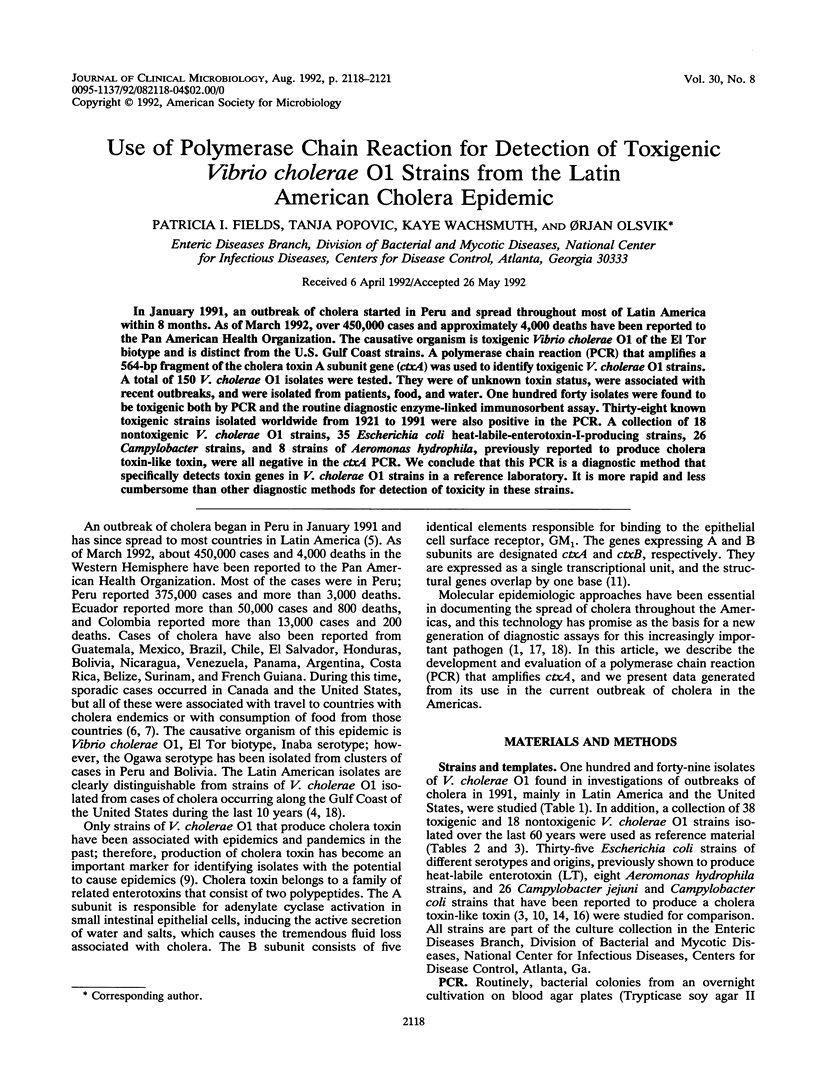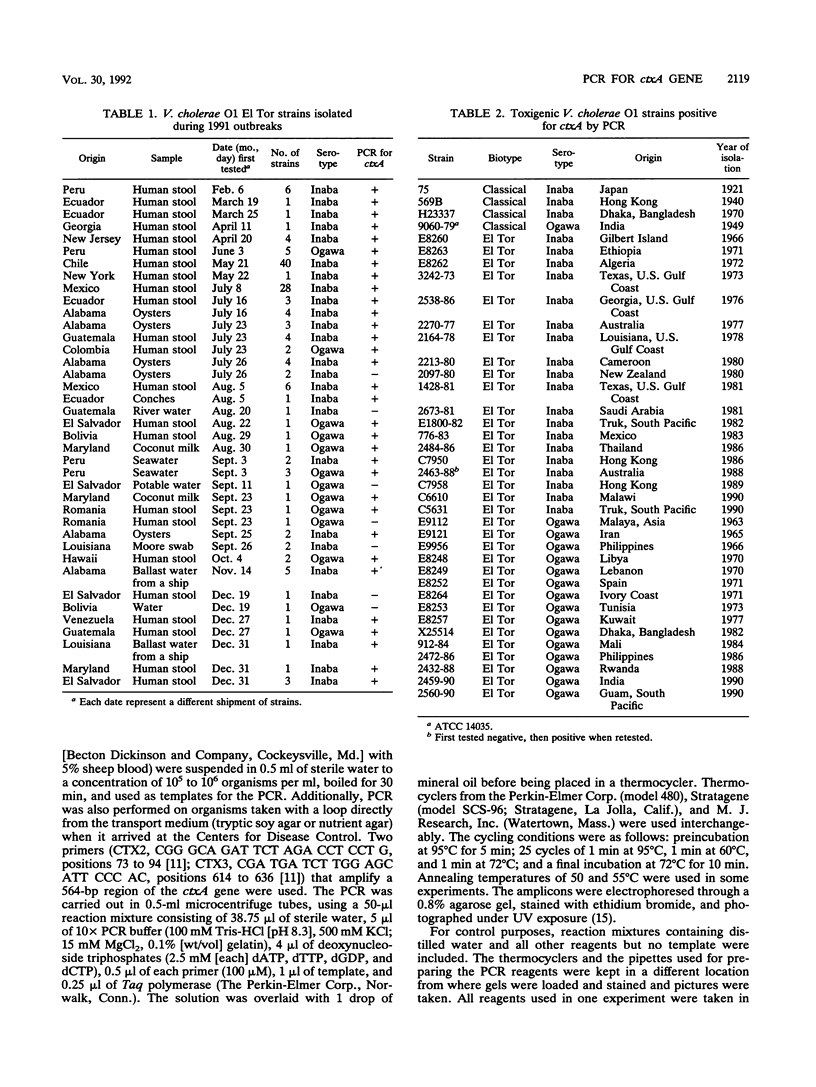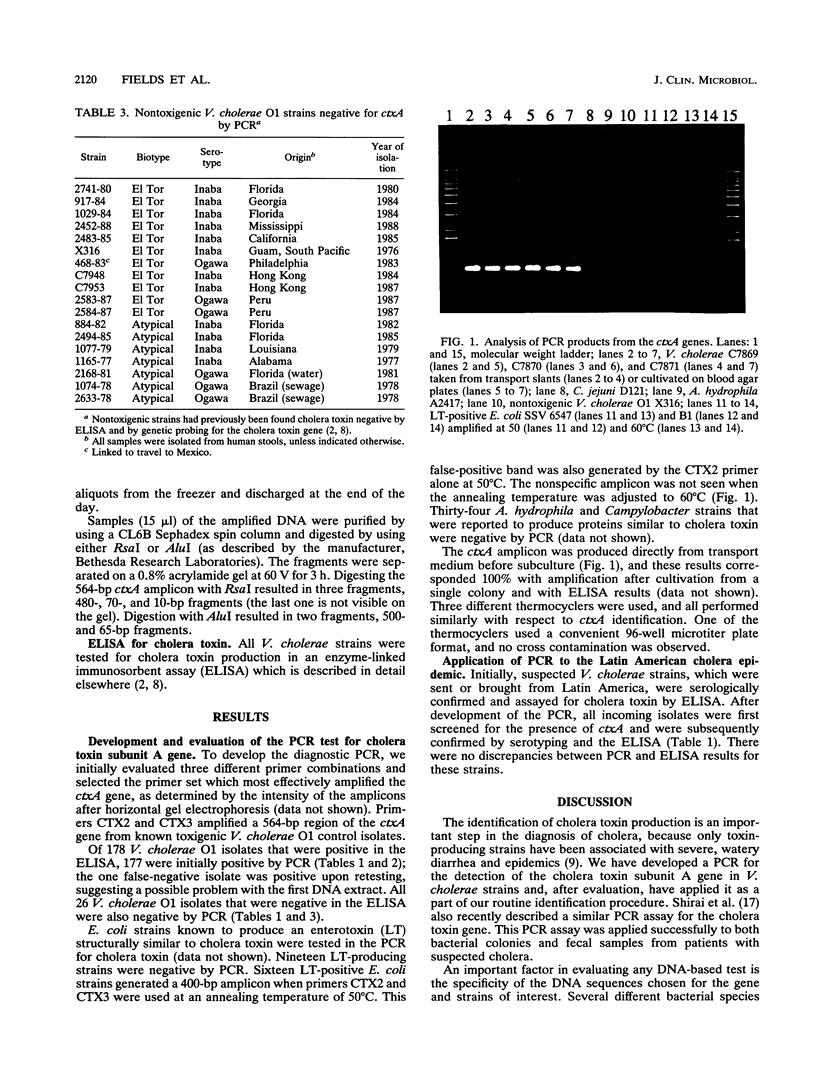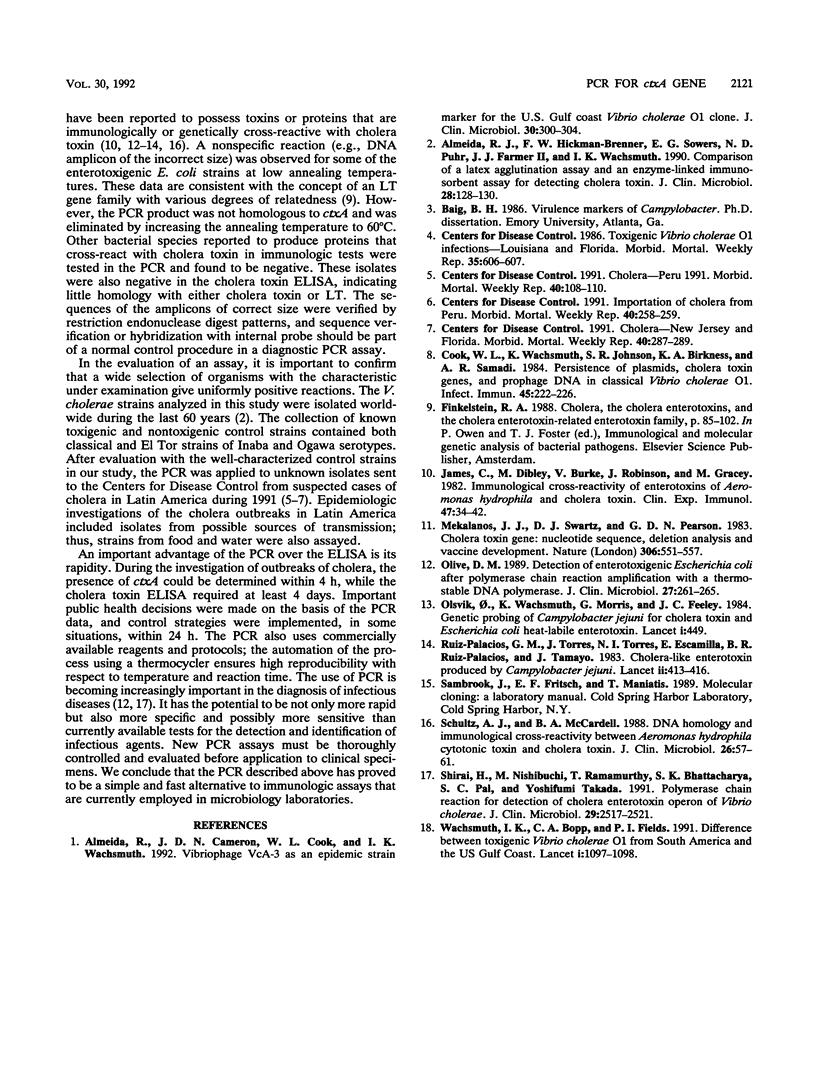Abstract
In January 1991, an outbreak of cholera started in Peru and spread throughout most of Latin America within 8 months. As of March 1992, over 450,000 cases and approximately 4,000 deaths have been reported to the Pan American Health Organization. The causative organism is toxigenic Vibrio cholerae O1 of the El Tor biotype and is distinct from the U.S. Gulf Coast strains. A polymerase chain reaction (PCR) that amplifies a 564-bp fragment of the cholera toxin A subunit gene (ctxA) was used to identify toxigenic V. cholerae O1 strains. A total of 150 V. cholerae O1 isolates were tested. They were of unknown toxin status, were associated with recent outbreaks, and were isolated from patients, food, and water. One hundred forty isolates were found to be toxigenic both by PCR and the routine diagnostic enzyme-linked immunosorbent assay. Thirty-eight known toxigenic strains isolated worldwide from 1921 to 1991 were also positive in the PCR. A collection of 18 nontoxigenic V. cholerae O1 strains, 35 Escherichia coli heat-labile-enterotoxin-I-producing strains, 26 Campylobacter strains, and 8 strains of Aeromonas hydrophila, previously reported to produce cholera toxin-like toxin, were all negative in the ctxA PCR. We conclude that this PCR is a diagnostic method that specifically detects toxin genes in V. cholerae O1 strains in a reference laboratory. It is more rapid and less cumbersome than other diagnostic methods for detection of toxicity in these strains.
Full text
PDF



Images in this article
Selected References
These references are in PubMed. This may not be the complete list of references from this article.
- Almeida R. J., Cameron D. N., Cook W. L., Wachsmuth I. K. Vibriophage VcA-3 as an epidemic strain marker for the U.S. Gulf Coast Vibrio cholerae O1 clone. J Clin Microbiol. 1992 Feb;30(2):300–304. doi: 10.1128/jcm.30.2.300-304.1992. [DOI] [PMC free article] [PubMed] [Google Scholar]
- Almeida R. J., Hickman-Brenner F. W., Sowers E. G., Puhr N. D., Farmer J. J., 3rd, Wachsmuth I. K. Comparison of a latex agglutination assay and an enzyme-linked immunosorbent assay for detecting cholera toxin. J Clin Microbiol. 1990 Jan;28(1):128–130. doi: 10.1128/jcm.28.1.128-130.1990. [DOI] [PMC free article] [PubMed] [Google Scholar]
- Cook W. L., Wachsmuth K., Johnson S. R., Birkness K. A., Samadi A. R. Persistence of plasmids, cholera toxin genes, and prophage DNA in classical Vibrio cholerae O1. Infect Immun. 1984 Jul;45(1):222–226. doi: 10.1128/iai.45.1.222-226.1984. [DOI] [PMC free article] [PubMed] [Google Scholar]
- James C., Dibley M., Burke V., Robinson J., Gracey M. Immunological cross-reactivity of enterotoxins of Aeromonas hydrophila and cholera toxin. Clin Exp Immunol. 1982 Jan;47(1):34–42. [PMC free article] [PubMed] [Google Scholar]
- Mekalanos J. J., Swartz D. J., Pearson G. D., Harford N., Groyne F., de Wilde M. Cholera toxin genes: nucleotide sequence, deletion analysis and vaccine development. Nature. 1983 Dec 8;306(5943):551–557. doi: 10.1038/306551a0. [DOI] [PubMed] [Google Scholar]
- Olive D. M. Detection of enterotoxigenic Escherichia coli after polymerase chain reaction amplification with a thermostable DNA polymerase. J Clin Microbiol. 1989 Feb;27(2):261–265. doi: 10.1128/jcm.27.2.261-265.1989. [DOI] [PMC free article] [PubMed] [Google Scholar]
- Olsvik O., Wachsmuth K., Morris G., Feeley J. C. Genetic probing of Campylobacter jejuni for cholera toxin and Escherichia coli heat-labile enterotoxin. Lancet. 1984 Feb 25;1(8374):449–449. doi: 10.1016/s0140-6736(84)91773-2. [DOI] [PubMed] [Google Scholar]
- Schultz A. J., McCardell B. A. DNA homology and immunological cross-reactivity between Aeromonas hydrophila cytotonic toxin and cholera toxin. J Clin Microbiol. 1988 Jan;26(1):57–61. doi: 10.1128/jcm.26.1.57-61.1988. [DOI] [PMC free article] [PubMed] [Google Scholar]
- Shirai H., Nishibuchi M., Ramamurthy T., Bhattacharya S. K., Pal S. C., Takeda Y. Polymerase chain reaction for detection of the cholera enterotoxin operon of Vibrio cholerae. J Clin Microbiol. 1991 Nov;29(11):2517–2521. doi: 10.1128/jcm.29.11.2517-2521.1991. [DOI] [PMC free article] [PubMed] [Google Scholar]
- Wachsmuth I. K., Bopp C. A., Fields P. I., Carrillo C. Difference between toxigenic Vibrio cholerae O1 from South America and US gulf coast. Lancet. 1991 May 4;337(8749):1097–1098. doi: 10.1016/0140-6736(91)91744-f. [DOI] [PubMed] [Google Scholar]
- Walker K. J., Nicholson R. I., Turkes A. O., Turkes A., Griffiths K., Robinson M., Crispin Z., Dris S. Therapeutic potential of the LHRH agonist, ICI 118630, in the treatment of advanced prostatic carcinoma. Lancet. 1983 Aug 20;2(8347):413–415. doi: 10.1016/s0140-6736(83)90386-0. [DOI] [PubMed] [Google Scholar]



